Food-Demand Analysis in Mexico: A Social Program´s Effects on Dairy Products Expenditure
Análisis de demanda de alimentos en México: impacto de un programa social en el gasto de las familias en productos lácteos
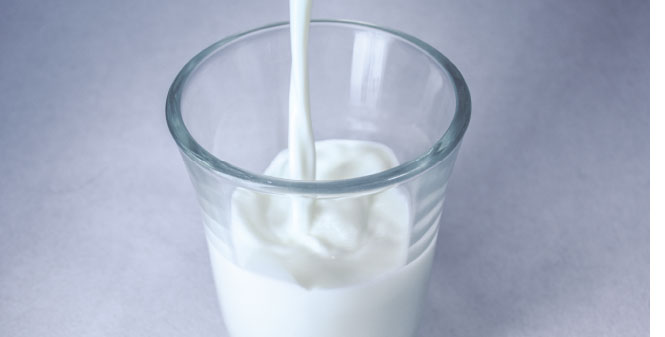
|
This paper presents an analysis of the dairy products’ demand in Mexico at a disaggregated level. We use data from individual household expenditure as well as demographics from 30 169 Mexican households, data collected in 2010 by the Mexican Statistical and Geography Institute (INEGI). The main objective of this study is to estimate the impact of the Oportunidades program; which is aimed to provide financial assistance to low-income families, whose dairy consumption is their main source of calcium. After using the Heckman model, we found evidence of the program beneficiaries spending more money on some dairy products than their counterparts. Estimates of price and expenditure elasticities are also provided. All the dairy commodities considered in this study are estimated to be normal goods and necessities. The results of this paper can be useful for public policies making in Mexico. Key words: Heckman Model; Oportunidades program; demand for dairy products; Mexico |
En este trabajo se presenta un análisis de demanda de productos lácteos en México a nivel desagregado. Se utilizan datos demográficos e información sobre el gasto de 30 169 hogares mexicanos, información compilada en el 2010 por el Instituto Nacional de Estadística y Geografía (INEGI). El objetivo principal del estudio es estimar el impacto del programa Oportunidades, el cual está enfocado a proporcionar asistencia financiera a las familias de bajos ingresos para el consumo de productos lácteos como principal fuente de calcio. Mediante el Modelo de Heckman se encuentra evidencia de que las familias beneficiarias del programa gastan más en algunos productos lácteos que sus contrapartes. Se proporcionan estimaciones de elasticidades precio y gasto. Todos los productos lácteos considerados en esta investigación son estimados como bienes normales y necesarios, de acuerdo con las elasticidades obtenidas. Los resultados de este trabajo pueden ser útiles para la toma de decisiones de política pública en México. Palabras clave: Modelo de Heckman; programa Oportunidades; demanda de productos lácteos; México. |
Recibido: 27 de junio de 2015
Aceptado: 11 de mayo de 2016
I. Introduction
Oportunidades program, originally known as Progresa, is a conditional cash transfer program in Mexico.1 Household members are required to participate in health education sessions and attend regular health check-ups to receive the program’s cash transfer. More than 5 million families receive these monthly cash transfers to help them improve their health, education, and nutrition. The health and education components of this program are mandatory and monitored. However, one feature of the program that is not enforced is the appropriate provision of nutrition supplements to children (Leroy, Vermandere, Nuefeld, and Bertozzi, 2008). Previous studies have found that Oportunidades has a positive impact on child growth in urban areas of Mexico (Leroy Garcia-Guerra, Garcia, and Dominguez, 2008). Other positive effects from Oportunidades relate to higher height growth rates and lower incidences rates of anemia in low-income, rural infants (Rivera, Sotres-Alvarez, Habicht, Shamah, and Villalpando, 2004).
This study is intended to provide evidence to answer the question of whether or not receiving Oportunidades translates into differential nutrition standards. Particularly, this paper will focus on the demand of dairy products, as the main source of calcium. The findings of Hoddinott and Skoufias (2003) suggest that beneficiary families drink more milk than those who do not participate in the program. The objective then is to go further and analyze how participating in the program changes acquisition of dairy products. Analysis on 16 disaggregated dairy products is performed to shed light into the effect of the program on choice of food products. The relevance of estimating the effectiveness of Oportunidades on nutrition is evident, given the number of households that receive this benefit and for its impact as a public policy in Mexico. As pointed out by Pitt (1983), choice of nutrient intake in households near subsistence levels is of obvious policy importance.
We used data from the National Income and Expenditure Household Survey (ENIGH), which is a nationally representative survey conducted during 2010. The analysis is performed through Heckman two-step procedure to find the effect of the program on dairy consumption by product category. Separability of the utility function for dairy products and for other food and non-food products was assumed.
Using Heckman two-step procedure, the estimates of the selection equation and the demand equation are obtained. In the selection equation, it was found that households that receive cash transfers and training from Oportunidades have a higher probability of consuming unpasteurized milk, unpasteurized cheese (queso fresco) and aged cheese, compared to household with similar demographics that did not participate in the program. Conversely, the households that participate in the program were found to be less likely to consume pasteurized milk, Oaxaca cheese and sour cream.
Own-price and expenditure elasticities-estimates for disaggregated dairy products are provided in this paper. Due to the economic relevance of the dairy industry, it is expected that the outcome of this paper be of interest of policy makers and business people.
As far as the relevance of the dairy market in Mexico is concerned, it is worth noting that the per capita milk consumption and other dairy products is 123 kilograms (Uribe and Torres, 2010). In 2010, average household expenditure on dairy products represented 12.3% of the total household expenditure on food (including expenditure on food away from home), and 15.6% of the expenditure of food consumed at home (INEGI, 2011). Around 60% of the production of fluid milk is utilized in the production of dairy products, which can be referred as industrial milk consumption. In 2010, the industrial milk consumption reached 6.9 million of metric tons, with an average rate of growth of 2.7% between 2005 and 2010. As for the direct milk consumption, the rate of growth is 1.6% for the same period, reaching 4.4 million tons in 2010 (Uribe and Torres, 2011). Further, since Mexico is a net importer of dairy products, understanding the behavior of these products in the Mexican market is not only of interest for domestic policy makers and local business people, but also for dairy producers and exporters abroad. The market for dairy products in Mexico was the destination for around 20% of the U.S. dairy exports during 2005 and 2010. It is worth noting that the total U.S. dairy exports in 2010 were 1.6 million tons (Uribe and Torres, 2011).
This paper is organized as follows: in section II a short summary of some of the main findings on the effect of Oportunidades is presented. Then, data and methods are described in sections III and IV, respectively. Section V contains the discussion of results and, section VI presents the main conclusions of this work as well as some opportunities for further research.
II. Literature Review
Oportunidades (Progresa) program was created in 1997 as a policy response to ameliorate the economic conditions of low-income families in México. After the 1995 crisis the level of poverty increased sharply. It went from 52.4% of the Mexican population living in poverty in 1994 to 69% of the population in 1996. Likewise, the proportion of Mexican population living below the food poverty line increased from 21.2% in 1994 to 37.4% in 1996 (CONEVAL 2011). The program has gradually evolved since its inception in 1997 to become what in 2016 is known as Prospera.
A detailed exposition on the social background where this program emerged and its evolution is out of the scope of the paper. For an overview of the political and economic context under which Mexico´s Oportunidades program was introduced, see Niño-Zarazúa (2010). Also, Czarnecki (2013) provides a description on recent poverty measurement strategies in Mexico.
Several papers have attempted to measure the effects of the program. Using data from the Mexican National Health and Nutrition Survey 2006, Mundo-Rosas, Rodríguez-Ramírez, and Shamah-Levy (2009) found evidence of a low intake of nutrients, particularly iron, zinc, folic acid, calcium, and vitamins A and C in preschool children of low socioeconomic status, especially those living in rural areas, and in southern Mexico. They found the presence of nutritional problems, but did not assess household participation in any social program aimed to reduce malnutrition.
It is also important to take into consideration that, because of the intergenerational transmission of poor nutrition, malnutrition may have long-term consequences. Thus, reduction in malnutrition has large potential economic benefits. Well-nourished children have significant gains in productivity and in cognitive achievement (Behrman and Hoddinott, 2005).
With respect to Oportunidades, Escobar Latapí and González de la Rocha (2008), report that a proportion of low income families in Mexico rely mainly on two sources of income: 1) remittances from migration to the United States, and 2) cash transfers from social policy programs such as Oportunidades.
Since its establishment in 1997, the main objective of Oportunidades was to reach the poorest households in rural Mexico. In its initial stages, Oportunidades stipends are allocated randomly across localities in the evaluation sample. That is, it was allocated to all eligible households within the randomly selected treatment localities. Eligibility was based on a poverty index (Behrman and Hoddinott, 2005). In contrast to earlier programs in Mexico, a unique feature of Oportunidades is the targeting of transfers to the mother (Hoddinott and Skoufias, 2003). The monthly transfer accounted for about 20% of the value of total household consumption (Todd, Winters and Hertz, 2010). Coverage of this program has increased significantly since its start. In June 2010 there were 5.6 million enrolled households in Oportunidades across the country (Andalon, 2011). The program provides cash transfers, food supplements, subsidies on school supplies, and health and education services to families below a certain socioeconomic threshold. In order to keep receiving the benefits, mothers and individual beneficiaries must comply with school attendance, health check-up as well as attendance to health and nutrition talks (Escobar Latapí and González de la Rocha, 2008). The program focuses on the health and nutrition of children and mothers. Leroy, Ruel and Verhofstadt (2009) provided a useful diagram (Figure 1) that depicts how programs such as Oportunidades may improve children’s nutrition.
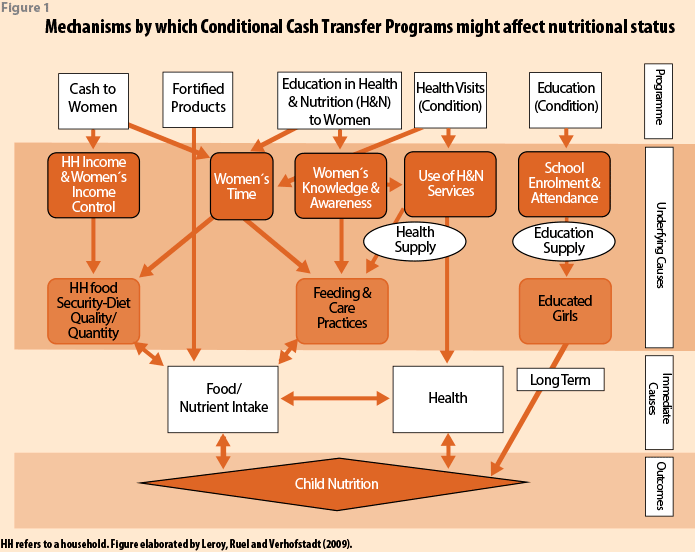
Oportunidades is a program that has been studied extensively. Some of these studies are briefly described here. An expected effect of the nutrition and health education component of the program, usually targeted at women, is that households’ preferences change towards nutrient-rich foods (Leroy, Ruel and Verhofstadt, 2009). On this matter, Hoddinott and Skoufias (2003), found that households receiving aid from Oportunidades (they refer to the program as Progresa), increased caloric acquisition compared to similar household not receiving the benefits. An important finding in this study was that the higher impact was on the consumption of highly nutritious foods such as fruits, vegetables and animal proteins.
Another study, conducted by Barber and Gertler (2008) used multivariate and instrumental variable analyses to estimate the impact of the program on birth weight. They found that beneficiaries of Oportunidades had children with increased birth weights of 127.3 grams or more and a 4.6 percentage point reduction in low birth weight. It is worth noting that pregnant women in participating households received nutrition supplements and health care, as well as cash transfers.
Leroy, Garcia-Guerra, Garcia, Dominguez, Rivera, and Neufeld (2008) used difference-in-difference propensity score matching to evaluate the impact of Oportunidades on the growth of children younger than 24 months of age that lived in urban areas. They found that children in intervened families and younger than 6 months of age grew more than children in control families. They concluded that Oportunidades, with its strong nutritional component, is an effective tool to improve the growth of infants in poor urban households.
As for the program effects on a rural environment, Rivera, Sotres-Alvarez, Habicht, Shamah, and Villalpando (2004) reported a finding of better growth and lower rates of anemia in low-income, rural infants and children in families that receive Oportunidades.
Behrman and Hoddinott (2005) evaluated nutrition by estimating the impact of the program on child height. A substantial and positive effect of the nutritional supplements on children between 12-36 months was found. Higher growth rates and lower probability of stunting were the main conclusions. They found that larger effects for children from poorer communities but whose mothers are functionally literate.
As discussed by Andalon (2011), theoretical and empirical health economics research suggests that Oportunidades could have affected adolescent weight. This author conducted a study on the causal effect of the program on overweight and obesity rates of youth living in rural areas. He found a reduction in the rate of obesity among female adolescents who participated in the program for 4 years on average. This effect is attributed by the author to increased schooling and access to information regarding the consequences of unhealthy behavior through health information sessions and regular visits to physicians; the education and nutrition component of the program. Further, Andalon (2011) suggested that given the identified local average treatment effect (LATE) at the threshold for program eligibility, female obesity would decrease if the program was expanded to cover households with a slightly better economic status.
On the impact of Oportunidades on productive activities, Todd, Winters and Hertz (2010), using first difference and weighted estimators (weights were constructed from propensity scores), evaluated the impact of the program on food consumption from own production, land use, livestock ownership, and agricultural spending. The results they obtained support the hypothesis that transfers influence agricultural production. Greater impacts were found for households invested in agriculture.
As it is clear from the cited literature, there is plenty of evidence that suggest that Oportunidades program has been successful in helping poor families to achieve better nutrition levels. However, to the best of my knowledge no study has been conducted, using the ENIGH, to explore at a disaggregated level the type of products that account for the increased intake of nutrients. In this paper I will focus on the analysis of demand for dairy products as the main source of calcium (an important micronutrient). Moreover, the objective of this study is to assess the impact of Oportunidades on the probability of purchasing these types of products (dairy) as a way to shed light into the factors that impact the decision making process to purchase or not products that contain calcium. The analysis is conducted utilizing the Heckman two-step estimator, in which the selection equation, that measures the probability of purchasing dairy products or not, and the demand equation, that estimates the quantity consumed once the household decided to purchase dairy products, are specified.
III. Data
The data used in this study was obtained from the National Income and Expenditure Household Survey (ENIGH), which is a nationally representative income and expenditure survey that was conducted by the Mexican Statistical and Geography Institute (INEGI) during the third quarter of 2010. This survey contains data on food consumption (at home and away from home) and the money value of food consumed during one week for 30 169 households. The data set also contains socioeconomic characteristics of the household, including geographical location, housing characteristics, number and age of members of the family, income, gender, and education level of the head of the household, among other factors. Moreover, the survey contains information about the marginality index of every county. This is a measure of the lack of access to elementary education, health services, infrastructure and development opportunities, which translates into low income families living in poor housing conditions. In the survey, all the sources of household income are disaggregated, allowing the identification of households that are beneficiaries of social programs such as Oportunidades.
As for the data manipulation to obtain the variables that were used in the model, and to obtain an estimation of prices, the household expenditure of a specific commodity was divided by the quantity they purchased. As expected in a household survey, it is common to find that a household does not report expenditure for all the commodities of interest. In those cases it is not possible to calculate a price for that specific commodity and household. To avoid missing values, the average price of the State was imputed for the commodity not consumed by the household. Expenditure on dairy was obtained by merely adding up the household expenditure for the 16 commodities under analysis. In this way, values for the variables quantity and price for the 16 dairy products, as well as for total expenditure on dairy were available for analysis. It is worth noting that the focus of this paper is on the food expenditure at home.
To account for the proportion of children living in a house, the number of children under 12 years old is divided by the total number of persons in the household. This variable is labeled as children ratio.
The rest of the independent variables in the model are as follows:
Marginalization index, which has 5 levels, is operationalized as a set of dummy variables, with value equals to 1 if the household belongs to a given level of marginalization, and equal to zero otherwise. The marginalization levels, according to the Mexican Agency known as CONAPO, are: Very High, High, Medium, Low and Very Low. In the model the level Very High marginalization is the reference level, that is, those households that live in the most unfavorable conditions. The variable female is a dummy variable that stands for the gender of the head of the household. This is equal to 1 if the head is a female, and zero otherwise. Age is an interval variable that measures the age of the head of the household. The variable Oportunidades is a dummy variable, which is equal to 1 if the family reported income from the program in 2010, zero otherwise.
The ENIGH 2010 collected data on 18 different dairy categories. However, for two of them, almost all households reported zero consumption during the survey period. For this paper, 16 categories of dairy products are considered. These are: pasteurized milk, condensed milk, evaporated milk, powder milk, modified milk or formula, unpasteurized milk, cheddar cheese, aged cheese, unpasteurized (fresh) cheese, manchego cheese, Oaxaca cheese, other types of cheese, sour cream, butter, yogurt, and other dairy products.
IV. Methodology
Estimation at the household level is preferred because it more readily permits the incorporation of household composition variables into the demand analysis, such as household size, occupation and employment status—information that is typically lost in aggregation. This is of particular importance in the study of nutritional well-being as it is the poorest households which are of special interest (Pitt, 1983).
As stated in the literature, the use of household- level data is preferable, since it avoids the problem of aggregation over consumers and often provides a large and statistically rich sample. However, data based on this kind of surveys convey a major estimation problem, namely zero consumption for many goods in a given household. Hence, we would be facing a censored dependent variable (Hein and Wessells, 1990).
As pointed out by Keen (1986), the presence of zero consumption values can be because of any of three broad factors:
When for at least one commodity there are households with zero consumption level, the application of the usual continuous variable estimation techniques would result in biased and inconsistent estimates because the random disturbances have nonzero means and are correlated with the exogenous variables. Moreover, dropping those households which do not consume at least one of the goods would severely reduce sample size and still result in inconsistent estimates (Pitt, 1983). To deal with this estimation problem some techniques have been proposed over the years, including the widely-used Tobit analysis, originally proposed by Tobin (1958). However, the Tobit regression model assumes that the probability mechanism generates both the zeros and the positive values in the dependent variable. This is a strong assumption (Cameron and Trivedi, 2010). If zero consumption is assumed to be due to sample selection, Heckman’s two-step is the appropriate model (Chern, Ishibashi and Taniguchi, 2003).
As discussed in Cameron and Trivedi (2010), the two-part model, unlike the Tobit model, attains some of its flexibility by assuming that: 1) the decision to spend, and 2) the amount to spend, are independent. That is, it has two-parts that are independently determined. The two-equation model includes a selection equation for ![]() , and an outcome equation for
, and an outcome equation for ![]() .
.

where ![]() is a latent variable that represents the outcome of interest, quantity purchased in our case. There is also the latent variable
is a latent variable that represents the outcome of interest, quantity purchased in our case. There is also the latent variable ![]() . The outcome of
. The outcome of ![]() is observed only if
is observed only if ![]() . In other words,
. In other words, ![]() determines whether the household buys dairy products (can also be interpreted as the propen- sity to consume) and
determines whether the household buys dairy products (can also be interpreted as the propen- sity to consume) and ![]() determines the quantity demanded. The regression model is:
determines the quantity demanded. The regression model is:

where ![]() and
and ![]() are the error terms assumed to be uncorrelated with the covariates, but may be correlated between them. It is assumed that the correlated error terms are jointly normally distributed and homoskedastic. Moreover,
are the error terms assumed to be uncorrelated with the covariates, but may be correlated between them. It is assumed that the correlated error terms are jointly normally distributed and homoskedastic. Moreover, ![]() and
and ![]() are vector of covariates for the selection and the out-come (demand) equation, respectively
are vector of covariates for the selection and the out-come (demand) equation, respectively ![]() and
and ![]() are vectors of coefficients for the selection equation (Probit model) and the demand equation (linear model).
are vectors of coefficients for the selection equation (Probit model) and the demand equation (linear model).
It is important to note that a two-step method is based on the following conditional expectation:
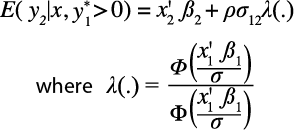
given, ![]() and the normality of the errors, then
and the normality of the errors, then ![]()
![]() . The term ρ measures the correlation between the error terms
. The term ρ measures the correlation between the error terms ![]() and
and ![]() . The term
. The term ![]() can be estimated by
can be estimated by ![]() and
and ![]() is obtained by a Probit regression of
is obtained by a Probit regression of ![]() on
on ![]() . As for the least squares part, it is estimated by regressing
. As for the least squares part, it is estimated by regressing ![]() on
on ![]() in the second step. The generated regressor, called the inverse Mills’ ratio is
in the second step. The generated regressor, called the inverse Mills’ ratio is ![]() , it is also known as the non-selection hazard (Cameron and Trivedi, 2010). This term takes into account a possible selection bias.
, it is also known as the non-selection hazard (Cameron and Trivedi, 2010). This term takes into account a possible selection bias.
For analysis, the marginal effects of independent variables were estimated. Special interest lies on the effect of the dummy variable Oportunidades on the consumption of dairy products. As discussed by Greene (2003), the marginal effect of the independent variables on ![]() in the observed sample consists of two components. First, there is the direct effect of the independent variable on the mean of
in the observed sample consists of two components. First, there is the direct effect of the independent variable on the mean of ![]() which is captured by the coefficients. Second, if the independent variable also appears in the selection equation, there is an indirect effect. This is because a change in some independent variables not only changes the mean of
which is captured by the coefficients. Second, if the independent variable also appears in the selection equation, there is an indirect effect. This is because a change in some independent variables not only changes the mean of ![]() , but also the probability that an observation is in the sample. Thus, the independent variables will affect
, but also the probability that an observation is in the sample. Thus, the independent variables will affect ![]() through the lambda term.
through the lambda term.
As for identification, the Heckman model is identified when the same independent variables in the selection equation appear in the outcome equation. However, Heckman model is appropriate when at least one explanatory variable is included in the selection equation, but not in the outcome equation. This is especially problematic when having small sample sizes because the Heckman procedure yields inconsistent and biased results when the exclusion restrictions are missing (Sartori, 2003). Also, Woldrigde (2010) points out that if all the variables in the selection equation also appear in the demand equation, the Heckman two-step (Heckit) estimates become imprecise.
To avoid this problem, in this case the variable that was included in the selection equation but not in the demand equation was the total quarterly income of the household. The dairy expenditure, a variable needed in the demand equation, was calculated as the sum of the expenditures for each dairy product.
V. Results and Discussion
Let us start this section with some descriptive statistics on the consumption of dairy products. Table 1 provides the mean and the standard deviation of quarterly consumption of dairy products by household. At household level, data is divided to compare the consumption level of families that receive Oportunidades and those that do not. For most of the 16 dairy products the average quarterly consumption is higher for those households that did not participate in the program. This is not surprising since dairy products are normal goods and households that received cash transfers from the Mexican government, through the social program, are low income families. On the dispersion of the consumption distribution, most of the commodities have a high standard deviation. It implies a highly skewed distribution to the right (since the lower bound of the distribution is zero).
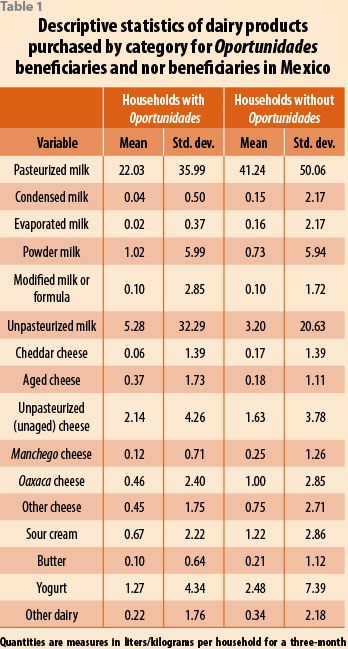
With respect to the descriptive statistics of the demographic variables used in the model, the head of the household is a female for 22% of the households receiving Oportunidades, compared to 26% in the households that are not part of the program. The mean and standard deviation for variables such as age of the head of the household, total members of the household, number of children under 12 years old, as well as quarterly income and expenditure on dairy is reported in Table 2.
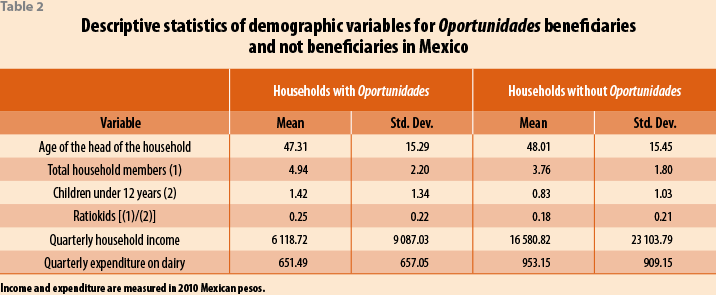
As for the empirical results, the Heckman model described in the previous section was estimated equation by equation for each of the 16 dairy products under analysis. The main objective was to evaluate the effect of participating in the program Oportunidades on the probability that the household purchased a given dairy product, controlling for the log of prices for all the dairy products, and the log of expenditure on dairy and demographic characteristics. In particular, the age and gender of the head of the household, the marginality index (as described in section III), as well as the ratio of kids under 12 years old to total number of persons that live in the household were controlled for in every equation. As mentioned by Cameron and Trivedi (2010) the two-part model uses a dependent variable in logs.
The first panel in Table 3 contains the coefficients of the first step in the Heckman model. The signs of the coefficients that are statistically significant in the probit part of the model suggest that Oportunidades has a positive impact on the probability of buying unpasteurized milk (p<.01), aged cheese (p<.05) and unpasteurized unaged cheese (p<.01). On the other hand, the probit coefficients for the variable Oportunidades have a negative sign for the equations for which the dependent variable is pasteurized milk (p<.01), Oaxaca cheese (p<.05) and sour cream (p<.05). For the rest of the products the coefficients are not statistically significant.
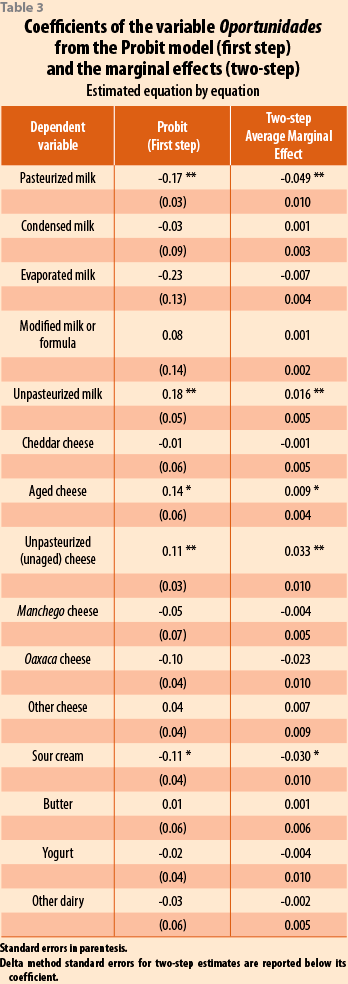
From the conditional expectation equation presented in section IV, it is easy to see that if ρ ≠ 0 and if the independent variable appears in both equations (selection and demand), then the Oportunidades coefficients do not indicate the marginal effect of the program on the probability of purchasing a given dairy product. As mentioned by Greene (2003), it is possible that the sign, magnitude and statistical significance of the marginal effect differ to those in the beta coefficients.
The ρ term was not statistically different from zero, i.e. the error terms in the selection equation and in the demand equation were uncorrelated, for the equations that had modified milk or formula, unpasteurized milk, butter and other dairy as the dependent variable. As mentioned by Wooldridge (2010), a standard t test on ρ is a valid test of the null hypothesis of no selection bias. However, for the eleven dairy commodities under analysis ρ was significantly different from zero (p<.05), hence in these cases the selection process and the demand equation are not uncorrelated. In the case of powder milk, the probit coefficient and the marginal effect were not estimated since the dependent variable was never censored because of selection, thus the model simplified to ordinary least squares regression.
The second panel of Table 3 introduces the average marginal effects of Oportunidades on the probability of purchasing dairy products. In particular, according to these estimates, a household that receives the benefits of the program increases the probability of consuming: 1) unpasteurized milk in around 2 percentage points; 2) aged cheese in around 1 percentage point; and unpasteurized cheese, also known as queso fresco, in around 3 percentage points. These average marginal effects are comparisons with respect to a household, of similar demographics, that is not a beneficiary of the program.
On the other hand, there is evidence that suggest that a household receiving Oportunidades is less likely to have a positive expenditure on (i.e. purchase) pasteurized milk (around 5 percentage points less likely), Oaxaca cheese (around 2.3 percentage points less likely) and sour cream (3 percentage points less likely) compared to a household that does not participate in the program.
If we consider that a decrease in expenditure does not necessarily mean a decrease in consumption (Aguiar and Hurst, 2005), then the decrease on probability of purchasing a positive quantity of pasteurized milk, Oaxaca cheese and sour cream, does not necessarily imply that Oportunidades has a negative impact on dairy consumption.
In this sense, the decrease in the probability of purchasing pasteurized milk may be explained by a substitution towards purchasing unpasteurized milk, which is produced locally in rural areas, or towards own-production. The nutrition talks, part of the program, might had an effect by providing training in managing unpasteurized milk (boiling it) to avoid the risk of food borne disease.
With respect to the decrease in the probabilities of purchasing Oaxaca cheese, it may be the case that it is produced at home, since it is relatively easy to elaborate manually. This is not an unfounded conclusion if we consider the findings of Todd, Winters and Hertz (2010), who reported that Oportunidades increased the value and variety of food consumed from own-production. They also reported an increase in livestock ownership, a fact that could explain the decline in the probability of purchasing pasteurized milk and Oaxaca cheese.
Elasticities
The estimated elasticities are own-price and expenditure. The later refers to the expenditure on dairy products, which was estimated under the separability assumption. With respect to the own-price elasticity estimates, it was found that all the parameters had a negative sign, as expected, and all but one of them are statistically significant (p<.01). The products that are estimated to be inelastic are pasteurized milk, powder milk, formula, unpasteurized milk, unpasteurized cheese, manchego cheese, sour cream, butter, and the category for other dairy products. Also, as shown in the second panel of Table 4, dairy products such as cheddar cheese, Oaxaca cheese, other cheese and yogurt are estimated to be own-price elastic. Moreover, condensed milk and evaporated milk are highly own-price elastic products (-2.25 and -2.33, respectively). Own-price elasticity for aged cheese was not statistically significant. As for the expenditure elasticity estimates, all dairy products have a positive and significant parameter (p<.01). Some dairy products, specially the different types of milk, have a large expenditure elasticity. However, in all cases the expenditure elasticities are less than unity.
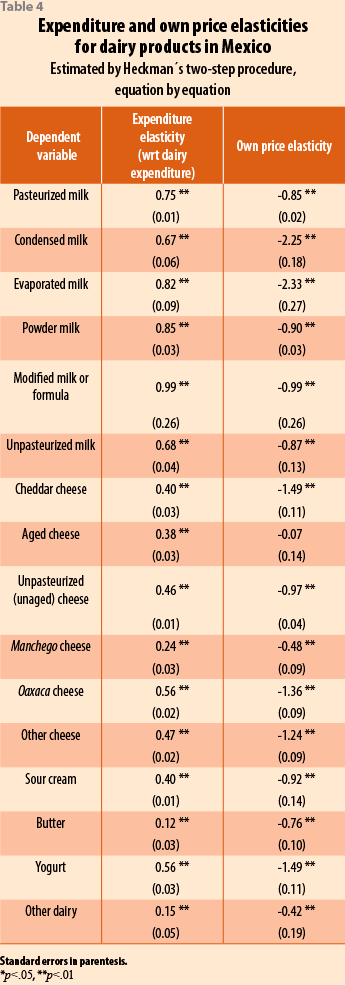
These findings are consistent with the results reported by Skoufias, Di Maro, Gonzalez-Cossio, and Rodriguez Ramirez (2009). They estimated, using a sample of poor rural household in Mexico, income elasticity for a variety of macro and micronutrients, including calcium. The income elasticities for calcium, estimated by Skoufias, Di Maro, Gonzalez-Cossio, and Rodriguez Ramirez (2009), go from 0.6 to 0.99 (p<.01) depending on the method used.
Large income elasticities for dairy products imply that an increase in household disposable income, which can be achieved by cash transfers and/or by increased productivity, would be an effective way to increase consumption of basic nutrients, such as calcium, in poor households in Mexico.
VI. Conclusions
Using Heckman two-step procedure, the estimates of the selection equation and the demand equation were obtained. In the selection equation, it was found that households that receive cash transfers and training from Oportunidades had a higher probability of consuming unpasteurized milk, unpasteurized cheese (queso fresco) and aged cheese, compared to household with similar demographics that did not participate in the program. Conversely, the households that participate in the program were found to be less likely to consume pasteurized milk, Oaxaca cheese and sour cream. These results suggest a substitution effect towards products that have a component of household production, such as boiling raw milk and production of cheese.
Own-price and expenditure elasticities estimates for disaggregated dairy products are also provided in this paper. Due to the economic relevance of the dairy industry in Mexico, it is expected that the outcome of this paper be of interest of policy makers and business people.
As stated in the paper, previous studies have suggested an increase in milk consumption as the impact of receiving the benefits of the program. In this paper, the effect on different dairy products expenditure was obtained. However, the overall effect of Oportunidades on calcium consumption by household was not estimated. Opportunities for further research include the estimation of consumption of dairy products accounting for calcium content by individual members of a household. Likewise, further analyses can be conducted controlling for different demographic variables, such as the level of education of the head of the family, the number of individuals in the family that report income, the occupation of families (agricultural producers or not), geographical region, whether the family belongs to an indigenous community, etc.
Given the disaggregation of the data set, home production for self-consumption is not distinguished in this paper (which is a subject for further research). Also, separability was assumed but not formally tested. This paper focuses on milk consumption as indicator of calcium consumption. Nevertheless, recommended intake of calcium was not considered in the analysis. Certainly, further effort is needed to complement this study with other nutrients and their demand analysis. Moreover, the analysis is done using only data from INEGI, more work needs to be done using different data source to test if the results are robust. One major area of opportunity for further research is to estimate the equations as a system, instead of equation by equation, in order to be able to estimate cross-price elasticities and formally test adding up and symmetry restrictions in the demand system. Finally, in order to improve robustness of the findings it would be interesting to perform estimation of the impact of the program on nutrition in low-income households using two-equation joint estimation and a Bayesian approach.
![]()
References
Aguiar, M. and Hurst E. 2005. “Consumption Versus Expenditure.” Journal of Political Economy, 113(5): 919-48.
Andalon, M. 2011. “Oportunidades to Reduce Overweight and Obesity in Mexico?”. Health Economics, 20 (Suppl. 1): 1-18 (2011).
Barber, S. L., and P. J. Gertler. 2008. “The Impact of Mexico’s Conditional Cash Transfer Programme, Oportunidades, on Birthweight”. Tropical Medicine and International Health, volume 13 No. 11 pp 1405-1414.
Behrman, J. R. and J. Hoddinott. 2005. “Programme Evaluation with Unobserved Heterogeneity and Selective Implementation: The Mexican PROGRESA Impact on Child Nutrition”. Oxford Bulletin of Economics and Statistics, 67, 4 (2005) 0305-9049.
Cameron, A. C. and P. K. Trivedi. 2010. “Microeconometrics Using Stata”. Revised edition. Stata Press, College Station, Texas.
Chern, W. S., K. Ishibashi, and K. Taniguchi. 2003. “Analysis of the Food Consumption of Japanese Households”. FAO, Social and Economic Development Paper No. 152. Rome, Italy, 2003.
CONEVAL. 2011. “Medición de la pobreza en México, 2008-2010”. Available at http://www.coneval.gob.mx/cmsconeval/rw/pages/medicion/Pobreza _2010/Anexo_estadistico.es.do (Accessed on September 13th, 2015).
Czarnecki, L. 2013. “El CONEVAL. La institucionalización del concepto oficial de la pobreza en México”. Revista Castellano-Manchega de Ciencias Sociales, Nº 16, pp. 177-190.
Escobar Latapí, A. and M. González de la Rocha. 2008. “Evaluating Progresa-Oportunidades”.
In S. Razavi (ed.) The Gendered Impacts of Liberalization: Towards Embedded Liberalism? Chapter 10, pp:435-468. Routledge/UNRISD, New York, 2008.
Greene, W. H. 2003. Econometric Analysis. New Jersey: Prentice Hall.
Hoddinott, J. and E. Skoufias, Y. 2003. “The Impact of PROGRESA on Food Consumption”. FCND Discussion Paper No. 150, International Food Policy Research Institute, Washington, DC.
Hein, D and C. R. Wessells. 1990. “Demand Systems Estimation with Microdata: A Censored Regression Approach”. Journal of Business & Economics Statistics. Vol. 8, No. 3 (Jul., 1990), pp. 365-371.
Heckman, James. 1979. “Sample Selection Bias as a Specification Error.” Econometrica 47:153-161.
INEGI. 2011. Encuesta Nacional de Ingresos y Gastos de los Hogares 2010. Instituto Nacional de Estadística y Geografía, July 2011. Accessed on April 2014. Available at http://www.inegi.org.mx/est/contenidos/Proyectos/Encuestas/Hogares/regulares/Enigh/Enigh2010/tradicional/default.aspx
Keen, M. 1986 “Zero Expenditures and the Estimation of Engel Curves”. Journal of Applied Econometrics, 1, 277-286.
Leroy, J. L., H. Vermandere, L. M. Neufeld, and S. M. Bertozzi. 2008. “Improving Enrollment and Utilization of the Oportunidades Program in Mexico Could Increase Its Effectiveness”. The Journal of Nutrition, 638-641, 2008.
Leroy, J. L., A. Garcia-Guerra, R. Garcia, C. Dominguez, J. Rivera, and L. M. Neufeld. 2008. “The Oportunidades Program Increases the Linear Growth of Children Enrolled at Young Ages in Urban Mexico”. The Journal of Nutrition, 138: 793-798, 2008.
Leroy, J. L., M. Ruel, and E. Verhofstadt. 2009. “The Impact of Conditional Cash Transfer Programmes on Child Nutrition: a Review of Evidence using a Programme Theory Framework”. Journal of Development Effectiveness, Vol. 1, No. 2, June 2009, 103-129.
Leroy, J. L., P. Gadsden, S. Rodríguez-Ramírez, and T. Gonzalez de Cossio. 2010. “Cash and In-Kind Transfers in Poor Rural Communities in Mexico Increase Household Fruit, Vegetable, and Micronutrient Consumption but Also Lead to Excess Energy Consumption”. The Journal of Nutrition, 140: 612–617, 2010.
Mundo-Rosas, V., S. Rodríguez-Ramírez, and T. Shamah-Levy. 2009. “Energy and Nutrient Intake in Mexican Children 1 to 4 years old. Results from the Mexican National Health and Nutrition Survey 2006”. Salud Pública Méx., 2009;51 suppl 4:S530-S539.
Niño-Zarazúa, M. 2010. “Mexico’s Progresa-Oportunidades and the emergence of social assistance in Latin America”. Brooks World Poverty Institute, BWPI Working Paper 142. ISBN : 978-1-907247-41-5.
Pitt, M. M. 1983. “Food Preferences and Nutrition in Rural Bangladesh”. The Review of Economics and Statistics, 65, 105-114 pp.
Rivera, J.A., Sotres-Alvarez, D., Habicht, J.P., Shamah, T., Villalpando, S. 2004. “Impact of the Mexican program for education, health and nutrition (Progresa) on rates of growth and anemia in infants and young children: a randomized effectiveness study”. JAMA. 2004; 291:2563-70.
Sartori, A. 2003. “An Estimator for Some Binary-Outcome Selection Models Without Exclusion Restrictions.” Political Analysis 11:111-138.
Skoufias, E., V. Di Maro, T. Gonzalez-Cossio, S. Rodriguez Ramirez. 2009. “Nutrient Consumption and Household Income in Rural Mexico”. Agricultural Economics, 40 (2009) 657-675.
Tobin, J. 1958. “Estimation of Relationships for Limited Dependent Variables”. Econometrica 26, 24-36.
Todd, J. E., P. C. Winters and T. Hertz. 2010. “Conditional Cash Transfers and Agricultural Production: Lessons from the Oportunidades Experience in Mexico”. Journal of Development Studies, 46:1, 39-67.
Uribe, L., and E. Torres. 2010. “Panorama Agroalimentario Leche y Lácteos 2010”. FIRA-Banco de México. Accessed March 2014. Available at http://www.fira.gob.mx
Uribe, L., and E. Torres. 2011. “Panorama Agroalimentario Leche y Lácteos 2011”. FIRA-Banco de México. Accessed March 2014. Available at http://www.fira.gob.mx
Wooldridge, J. 2010. Econometric Analysis of Cross Section and Panel Data. Cambridge: MIT Press. Second edition.
![]()
1 In 2013 the program was renamed as Prospera




